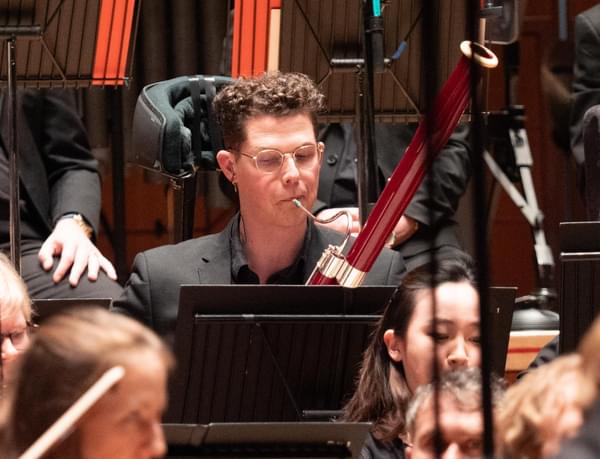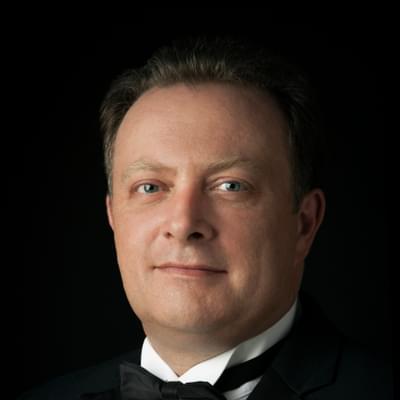Youth Orchestra Academy

Full programme
- Haydn, Symphony No.101 (The Clock) (29mins)
- Weber, Bassoon Concerto (19mins)
- Beethoven, Symphony No.7 (32mins)
Performers
Introduction
Welcome to this evenings concert at the iconic Town Hall which will feature ticking clocks, marching drums and boisterous Beethoven.
Our concert begins with Symphony No. 101, composed by the son of a wagon maker – Joseph Haydn. Haydn is well known for his sense humour which naturally makes its way into his compositions, making his pieces entertaining to play. In this symphony, Haydn includes something unusual in each movement. You can listen out for the famous tick tock quavers played by the second violins and celli in the second movement which gives this symphony it’s apt nickname – The Clock.
Next, we delve into the world of Carl Maria von Weber and his beautifully lyrical and virtuosic Bassoon Concerto. Weber, a humble miller’s son, sneakily added the baronial title ‘von’ to his name to successfully create an aura of respectability. Weber’s concerto displays a wide range of characteristics: the first theme is cocky and triumphant (rather like the ‘von’ title) and the second theme is calmer and reflective. My favourite character in the piece is the witty, laughing passages in the 3rd movement and I am really looking forward to hearing and watching our wonderful soloist Nikolaj’s bubbly personality shine through especially in this cheeky and challenging movement.
Our concert concludes with a Beethoven’s 7th Symphony, which he modestly described as “one of his best works.” The audience at its premier in Vienna 1813 evidently agreed as they demanded that the second movement be repeated, which is not a usual occurrence. In the premiere, the violinist Spohr said that, as a conductor, “Beethoven had the habit of conveying expression to his orchestra by all sorts of peculiar motions of the body.” Weber thought that Beethoven’s conducting meant that he “was ready for the madhouse.” His eccentric energy is directly infused into the lively and thrilling rollercoaster of the symphony to come!
Zinnia Smart
CBSO Youth Orchestra Member
Programme Notes
Ticking clocks, marching drums and boisterous Beethoven. Haydn’s Symphony 101 ‘ticks’ all the way through its second movement, while the bassoon shares the stage with a pounding timpani in Weber’s Concerto. The CBSO’s Nikolaj Henriques does the honours in the Weber, before we hear Michael Seal lead the CBSO Youth Orchestra in Beethoven’s most cheerful, dancing symphony.
Symphony No.101 in D major ("The Clock")
Franz Joseph Haydn (1732-1809)
I. Adagio – Presto
II. Andante
III. Menuet: Allegretto
IV. Finale: Vivace
Eighteenth century composers didn’t tend to name their instrumental pieces. So the nicknames by which we now know five out of the twelve symphonies that Haydn wrote for British audiences tell us something remarkable. Nicknames were bestowed by publishers, promoters or the public when a work had become particularly well-loved or familiar. Long before anyone had thought of cataloguing Mozart’s or Haydn’s music, they were a shorthand – after all, “Symphony in D major composed by Joseph Haydn” could refer to one of 23 different works! (Even adding “in London” only narrows it down to 4). But more importantly, they were an accolade - proof that listeners wanted to remember and revisit a particular work. The nickname “The Clock” first appears on a printed edition of this symphony in 1798, just four years after its first performance at the Hanover Square Rooms, London, on 3rd March 1794.
And even by the standards of the Georgian media-frenzy that surrounded Haydn’s two visits to London (1791-2 and 1794-5), Haydn’s 101st symphony was a hit. Two previous seasons of concerts in London had sharpened Haydn’s crowd-pleasing instincts; now, with the impresario Salomon’s orchestra expanded to include two clarinets, his inspiration burned brighter and fresher than ever. Everyone could hear it. “The most delicious part of the entertainment was a new grand Overture [ie, Symphony] by Haydn; the inexhaustible, the wonderful, the sublime HAYDN!” reported the Morning Chronicle, with true tabloid gusto. “The first two movements were encored; and the character that pervaded the whole composition was heartfelt joy. Every new Overture he writes, we fear, till it is heard, he can only repeat himself; and we are every time mistaken”.
And no question, the 61 year old composer had some new tricks up his sleeve. “Nothing can be more original than the subject of the first movement” remarked that first critic, clearly recognising Haydn’s use of a main theme that’s basically a jig for the bold and exuberant gesture it was (and all the more brilliant for coming after so dark and expressive an Adagio introduction). “The accompaniment of the andante, though perfectly simple, was masterly” (and it wouldn’t be long before that accompaniment would give the symphony its name). “And we never heard a more charming effect than was produced by the trio to the minuet” – though Haydn’s joke of making the solo flute dance over an accompaniment that’s jammed like a broken musical clock was also boldly dissonant. As for the finale, Haydn’s biographer H.C. Robbins Landon considered it “the greatest symphonic last movement of Haydn’s career”. But it seems that the first audience had the measure of that too: “It was HAYDN, what can we, what need we say more?”
Bassoon Concerto in F major, Op.75
Carl Maria von Weber (1786-1826)
I. Allegro ma non troppo
II. Adagio
III. Rondo: Allegro
With Carl Maria von Weber, you can take your pick – classical or romantic. Weber had the ultimate classical pedigree; he was first cousin of Mozart’s wife Constanze. Yet his opera Der Freischütz, (1821) embraced the world of early German romanticism like none before. It was a dark and magical world – and Weber’s woodland horns, moonlit strings and brooding clarinets showed a whole generation of composers how it could be translated into music.
The Bassoon Concerto straddles both worlds, even if the story of its birth sounds like something out of an 18th century comedy. Banished from the court of Wurttemberg after being caught red-handed in – well, let’s just call it a minor financial indiscretion – Weber headed early in 1811 for the music-loving court of Munich. As a sort of musical calling-card, he ran up a perky little Concertino for Heinrich Baermann, clarinettist of the Court orchestra – and his success was assured: “The whole orchestra has been the very devil about demanding concertos from me!” he declared, delighted.
He wrote this concerto for the Munich court bassoonist Georg Friedrich Brandt in less than a fortnight in November 1811, and had skipped town once more by the time Brandt premiered it shortly after Christmas. By all accounts, Brandt was delighted, and who can blame him? The first movement combines comic opera bustle with an unmistakable ceremonial swagger (a marching rhythm on the timpani heralds the bassoon’s first entry), before the Adagio lets the bassoon sing like an operatic tenor. And then the sparkling final Rondo unleashes the bassoon’s potential for comedy with remarkable agility and grace. Weber didn’t get away with as much as he did without knowing when to keep things tasteful – and when to go for broke.
Symphony No.7 in A major, Op.92
Ludwig van Beethoven (1770-1827)
I. Poco sostenuto – Vivace
II. Allegretto
III. Presto
IV. Allegro con brio
New music often has a troubled birth. Beethoven’s Seventh Symphony was premiered in Vienna on 8th December 1813. The occasion was a benefit concert for Austrian soldiers wounded in the recent Battle of Hanau, and the impresario Johann Mälzel had assembled an all-star orchestra. The virtuoso violinist Schuppanzigh was the leader, Dragonetti (the father of modern bass playing) led the basses, and the composers Spohr, Meyerbeer and Romberg sat in the strings, as did the guitar virtuoso Mauro Giuliani (on cello). Johann Nepomuk Hummel (composer of the famous trumpet concerto) was on timpani, and offstage, cuing the special effects in Beethoven’s other contribution to the evening, the so-called “Battle-Symphony”, was living legend Antonio Salieri. But even a super-group of this calibre couldn’t cope with the Seventh Symphony. The future music publisher Franz Glöggl was at rehearsals, and witnessed the difficulties. Music that couldn’t be played shouldn’t be written, protested the violinists.
Unbelievably, Beethoven kept his cool, and “begged the gentlemen to take their parts home with them” to practice. They did, and the performance was one of the supreme triumphs of Beethoven’s career. The Allegretto was encored, and a delighted Beethoven wrote to a Viennese newspaper, to thank his “honoured colleagues” for “their zeal in contributing to such a splendid result”. Mind you, there would be dissenters – Weber listened to the first movement and declared that Beethoven was “ripe for the madhouse”. Clara Schumann’s father, Friedrich Wieck, was convinced that Beethoven must have been drunk when he wrote it.
They had a point. It’s not just the Symphony’s rough-cut humour (after the massive build-up of energy in the introductory Poco sostenuto, the Vivace launches not with a breaking storm, but a country-dance tune on the flute). And it’s not just the way each movement is driven by colossal build-ups of dance rhythms (even the Allegretto has the rhythm of a pavane). It’s the sheer, elemental energy with which Beethoven brings it off. Exuberance is written into the Symphony’s very texture. By setting the symphony in A major, Beethoven automatically made life difficult for the brass players – and the sound of the horns, whooping through the climaxes at the very top of their register, means that the symphony can’t help but feel exhilarating, unbridled and wild.
Even the quieter, slower music is compelling – that melancholy Allegretto is both one of the simplest and most sophisticated movements Beethoven ever wrote, and the echoing horn calls in the third movement’s central interlude set the tone for a century of Romantic orchestral music. As for the torrential gallop of the finale: well, perhaps Wieck was onto something after all. Listen to those whirlwind strings and untamed brass, and then think of Beethoven’s own words: “Music is the spirit that inspires us to new creation; and I am the Bacchus, who presses out this glorious wine to intoxicate all mankind”.
© Richard Bratby
Featured image © Hannah Fathers

